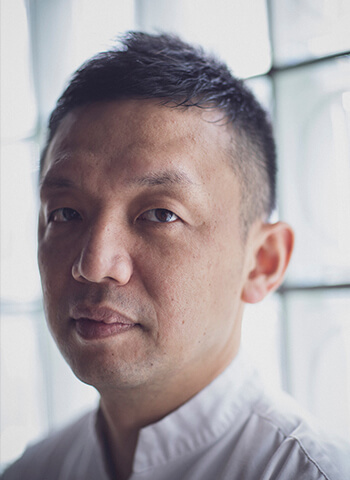






『てのしま』主人 | 日本料理アカデミー正会員
1976年香川県丸亀市生まれ岡山県玉野市育ち。立命館大学卒業後、株式会社菊の井に入社。
2011年上海万博にて『料亭 紫
MURASAKI』(日本産業館内)の料理長として赴任。2011年菊乃井本店副料理長就任、2015年菊乃井赤坂店渉外料理長就任。菊乃井主人村田吉弘氏に師事し、シンガポールエアライン機内食の開発やJR西日本『瑞風』のメニュー開発、国際会議や首相官邸での晩餐会での料理を担当。17カ国以上で和食普及のためのイベントに携わる。また、日本料理を学びたい外国人のための制度作りでは京都府と共に尽力した。
日本料理の出汁素材は、海の恵みがほとんどを占める中で、貴重な山の出汁素材である干し椎茸は、野菜の中でも突出した旨味をもつ食材です。
生の椎茸にそこまで旨味があるわけではないのですが、干すことで椎茸特有の旨味成分グアニル酸が何倍にも増えるのです。さらに椎茸は出汁素材として使われるだけでなく、食材としても食べられる特徴があります。
干し椎茸は古くから「時知らず」といわれて重宝された乾物の代表格で、人工栽培が安定する昭和初期までは高級食材のひとつでした。炊いた椎茸は、昔からハレの日の巻き寿司やちらし寿司には必ず登場します。主役ではないけれど、ないと物足りない、まさに料理の名脇役だといえるでしょう。
干し椎茸といえば香りが苦手、という方が多いかもしれません。僕もあまり得意ではないのですが、動物性の旨味と合わせた時に素晴らしい相乗効果を生み出し、その癖のある匂いが複雑な旨味の元になります。たとえば豚の角煮の汁に少し加えたり、炒り鶏を干し椎茸の出汁でつくるのがおすすめです。

©︎ Osamu KURIHARA / TOKYO-GA


僕の母は、昆布といりこに少しだけ干し椎茸を加えた“水出し”を、いつも冷蔵庫にストックしています。昆布とちょっと癖のあるいりこが織りなす旨味、そこに干し椎茸の香りが付与され、複雑でありながらも飽きない味わいは、普段使いの出汁として無敵だと思います。
さて今回は、僕の母のレシピをさらにおいしく、作りやすくした椎茸といりこの出汁をご紹介します。いりこ単体とは一味違う出汁をお楽しみください。
この出汁をとった後の椎茸を冷凍庫に貯めておいて、“椎茸の艶煮”を作ることをおすすめします。小分けして冷凍しておくと、そうめんに添えたり、お弁当に入れたり、便利に使えます。

©︎ Osamu KURIHARA / TOKYO-GA


家庭でも作り易い分量を目安とします。


Illustration ©︎ Yuka OHTA



Owner of ‘Tenoshima’ and Full member of the Japanese Culinary Academy
Born in Marugame (Kagawa Prefecture) in 1976, and raised in Tamano City (Okayama Prefecture). After graduating from Ritsumeikan University, he started to work in Kikunoi. After considerable training, in 2011 he was appointed as the head chef of the Japanese restaurant ‘MURASAKI’ in the Japanese Industry Pavilion at the Shanghai World Expo. In the same year, he became sous-chef of Kikunoi’s main restaurant, and in 2015 became the International Liaison head chef of the Kikunoi Akasaka restaurant. Under the guidance of Mr. Yoshihiro Murata, Kikunoi’s owner, he was in charge of developing in-flight meals for Singapore Airlines, developing menus for JR West rail’s "TWILIGHT EXPRESS MIZUKAZE", and preparing food for international conferences and banquets at the Prime Minister's official residence. He has been involved in events to popularise Japanese food in more than 17 countries. In addition, he worked with Kyoto Prefecture to create a system for non-Japanese who want to study Japanese cuisine.
While most of the dashi (soup stock) ingredients in Japanese cuisine are sourced from the sea, dried shiitake musrooms (a precious ingredient of Mountain Dashi) are a vegetable with outstanding umami.
Raw shiitake mushrooms are not so delicious, but when dried the umami component guanylic acid, unique to shiitake mushrooms, multiplies many times over. Furthermore, shiitake mushrooms are not only used as a base ingredient for dashi, but they can also be enjoyed in their own right.
Dried shiitake mushrooms have long been called ‘timeless’ and seen to represent dried foods, which until the early Showa period (1926-1989) when artificial cultivation became more stable, were seen as a high-class food item. Cooked shiitake mushrooms have always made an appearance in dishes such as makizushi (sushi rolls) and chirashizushi (scattered sushi) during celebrative occasions.
Quite a few people dislike the smell of dried shiitake mushrooms. I’m the same, but when combined with the umami of meat, it creates a wonderful synergistic effect and this distinctive scent is the source of truly complex umami flavours. For example, it is recommended to add a little to the dashi in Buta-no-Kakuni (braised pork belly), or to make Iritori (chicken with root vegetables) with the dashi of dried shiitake mushrooms.

©︎ Osamu KURIHARA / TOKYO-GA


My mother always has mizudashi, a mixture of water, kelp, iriko (dried small sardine) and a little dried shiitake mushroom, in stock in the fridge. The umami flavour of kelp and the distinctive scent of sardines, combined with dried shiitake mushrooms, creates a complex yet timeless flavour that I think is unbeatable as a dashi for everyday use.
This time I would like to introduce this shiitake mushroom and iriko dashi, a more simple and even more delicious version of my mother’s recipe. Please enjoy this dashi with a difference. After the soup stock is complete, I recommend storing the shiitake mushrooms in the freezer to make Shiitake-no-Tsuyani (glazed shiitake). If you divide it into small pieces and freeze it, it can be conveniently added to somen noodles, or served in your bento lunch box.

©︎ Osamu KURIHARA / TOKYO-GA

